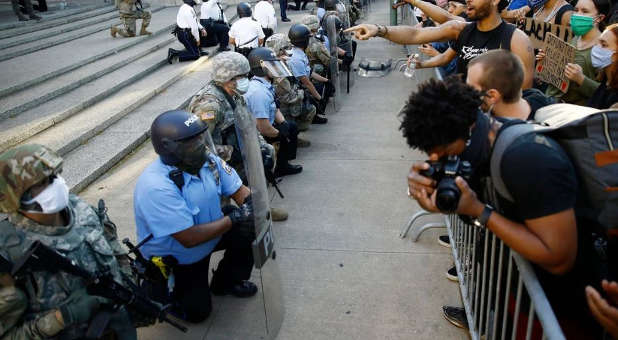Will Police Officers’ Bended Knee Gesture Make a Difference?
The scene was repeated this past week in city after city.
As thousands of people demonstrated against the death of George Floyd, the 46-year-old Minneapolis black man killed in police custody, police officers and other law enforcement agents took the knee in a symbol of solidarity with protesters.
From Boston to Spokane, Washington, scenes of officers dropping to their knees—often accompanied by cheers—made for dramatic headlines and images.
The gestures were intended to show support for the protests and to underscore officers’ humanity in the face of ongoing police brutality, of which Floyd was the most recent example.
But the gesture of officers taking the knee in the midst of a national upheaval over race and police brutality is fraught.
In Christianity and Islam, kneeling is a sign of veneration—meant to express devotion, humility and supplication toward God.
“It’s a sign of reverence,” said Luke Bretherton, professor of moral and political theology at Duke Divinity School. “We get our grammar of it from religious frames of reference.”
Catholics kneel during Mass. Muslims bow, kneel and place their foreheads to the ground during salah prayers. Jews bend the knee and bow during the Aleinu prayer.
In secular settings, it’s a sign of respect. A person may take the knee to propose marriage. A soldier may take a knee at the grave of a fallen fighter.
That’s what Nate Boyer had in mind when he convinced former San Francisco 49ers quarterback Colin Kaepernick kneel during the national anthem as a way of protesting police brutality. Kaepernick had previously been sitting on a bench during the anthem.
“I thought kneeling was more respectful,” Boyer, a former Green Beret and NFL player, told NPR in 2018.
But the following year, President Donald Trump began attacking players who took the knee, saying that kneeling was a form of disrespect for the U.S. flag and anthem, especially when others were standing.
NFL owners eventually ruled that players could no longer kneel during the anthem without being subject to punishment.
But now police officers, police chiefs, mayors, U.S. senators, even a Catholic bishop, have adopted the gesture as their own way of showing contrition and solidarity with protesters’ anger over the death of Floyd.
“All police officers don’t think the same,” Boston Police Officer Kim Tavares told a reporter for WCVB. “Black lives do matter. When you have stuff like this, you still have to show them love.”
But the optics of police officers on their knees is not entirely welcome. As sportswriter Sally Jenkins pointed out, the knee is the very anatomical joint Officer Derek Chauvin used to pin Floyd on the ground and choke him.
“For many of us, there’s something heartfelt to be experienced in seeing protesters and police officers pray together, hug, kneel together,” said Mark Anthony Neal, the James B. Duke professor of African and African American studies at Duke University. “Those are important gestures that highlight our humanity in this moment. But the protesters are asking for more. They’re asking officers to be willing to undermine the blue line of silence to hold their own peers accountable for their behavior. If those steps don’t occur in actual police departments, the hugs and kneelings are empty gestures and, at worse, photo-ops.”
Black Lives Matter co-founder Patrisse Cullors went further, saying she found the gesture of taking the knee “disingenuous.”
“These things don’t happen through police taking a knee at protests and then right after they take a knee, getting up and tear-gassing us and rubber bulleting us and beating us with batons,” Cullors told Boston radio station WBUR.
Others, too, viewed the gesture skeptically, as a strategy intended to de-escalate or defuse a protest that may be turning violent.
One reason why the gesture of kneeling on one leg may not be persuasive is that, as with personal religious gestures, it comes down to an individual, said J. Kameron Carter, professor of religious studies at Indiana University Bloomington who studies race.
Carter said he was willing to grant that these police officers taking the knee were genuine in their opposition to the behavior of the Minneapolis police.
But he added: “We still want to talk in terms of bad cop, good cop. The issues are being interpreted not in terms of a structural problem in this country, but policing at the individual level.”
Many protesters want structural changes, such as defunding law enforcement, demilitarizing police, repealing laws that grant police “qualified immunity” from accountability for illegal actions and other wide-ranging reforms.
William Sturkey, professor of history at the University of North Carolina at Chapel Hill, said that ultimately, kneeling as symbol may not work.
“This movement was not designed to convince police to take the knee with protesters,” he said. “It was designed to have our country open its eyes and deal with systematic racial discrimination in policing in a very real way. The kneeling will be for naught if it just ends there.” {eoa}














































